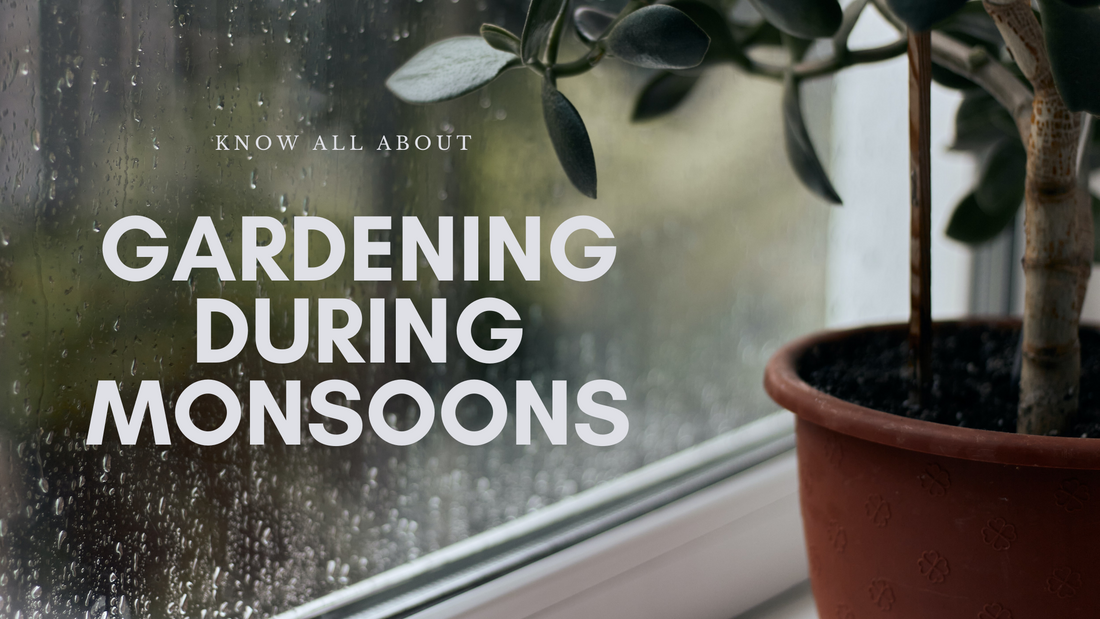
The season of rains is finally upon us to give us and our leafy greens a much needed escape after the harsh Summer sun. One of the most conducive climate to support plant growth, both indoors and outdoors, is this season. Factors like reduced sun intensity, high humidity and lowered temperature acts as a natural catalyst for plant growth. Rainwater is essentially soft water, and contains traces of nitrogen, making it an able candidate to support plant growth. Hence, an accelerated growth in all plants can be expected.
However, more is not always better. With an overcast sky, and humid environment, Monsoon comes with its own sets of watering and pest issues.
How To Make Your Plants Monsoon Friendly
However, with very few simple tricks and tips, it is very easy to cater to your plants and keep them happy during this season. Let’s read along how to make your plants Monsoon friendly!
 WATERING
WATERING
Watering is one of the important aspects and perhaps the most tricky one when it comes to potted plants during Monsoons. If you have an outdoor garden then make sure that there is no stagnant water on the pot. Make sure to drain them out to avoid root rotting and moisture imbalance. Move your pots to a partial shaded location, where the can get access to limited rain water.
But how much to water and when to water for the indoor plants?
It’s quite simple actually. Go with this thumb rule of watering plants during Monsoons - if the top inch of the soil is dry, water the plant, otherwise let the soil dry for a day or two before your next watering session. Try to water in the mornings at around 7-8 am, so that as the day's temperature increases, moisture can get evaporated.
PEST INFESTATION
With humid surroundings and a damp soil, worms and fungus gnats (in the soil) and mealy bugs and powdery mildew (on the leaves and stems) are very likely to visit your little friend. Make sure to check the soil, leaf undersides and nodal regions of the plant every alternate day to keep a lookout for pests. Keep Neem Oil handy during this time, as it is one of the organic ways to reduce or prevent infestations. Keep some organic pesticides and fungicides as well, to combat these kinds of issues.
PHYSICAL SUPPORT
Rains are often accompanied by strong winds. If your plants face strong winds, you can tie the plant to a stick ensuring that your plants don’t get uprooted due to the strong winds and rain. You can also poke holes on a plastic sheet and use it to cover the plant with the perforated sheet, to avoid them getting too much water and wind stress. Perforated sheets are getting extremely popular with new age gardeners (and for a good cause!) to ensure that the plant gets proper light but not excess water.
PRUNING

Monsoon is widely known as the season of growth and in order to make way for new growth, it's important to trim away the excess parts. For potted plants, always trim and cut off those stems that are not yielding any flowers, have grown long and lanky and are not showing any new growth. Cutting the wayward branches and deadheading spent blooms, sets the plant in motion for new shoot growth. Pruning ensures that the plant has only the required foliage to survive the long, dormant winter months and then to progressively grow fresh in the new season.
FERTILIZATION AND EARTHWORMS
Too much water runs down the soil. This means that you will need to add another top layer with a well-draining potting mix. As soil rundown leads to flushing out of nutrients, try to use a slow-releasing organic liquid fertilizer for the plants that will ensure that the plants are properly nourished. This is a good time to utilize the deep burrowing earthworms that will naturally fertilize the soil.
WEED AND ALGAE
With such favorable conditions, weeds and algal matter will sprout and create a thin film over the soil's top layer. Pull out the weeds as soon as you see one, so that it doesn't get a chance to soak up your plant's nutrients. With the algae, you might need to scrape out the green algal matter as soon as it starts growing.
High Growth Plants For The Monsoon Season
These are some of the plants for growing during monsoons that show sporadic growth and pave their way into winters:
- Flowering plants - Hibiscus, Jasmine, Anthurium, Pentas, Ixora, Periwinkle
- Indoor Foliage plants - Monstera, Syngonium, Philodendrons, Money Plants
That being said, it might seem a bit hectic, especially for busy plant parents, to maintain a schedule for each plant. But a little time every week goes a long way. Devoting some time early morning to your leafy friends will ensure that you get a hang of what your plant needs, making it easier for you to take care of them in future!



1 comment
Great, useful post